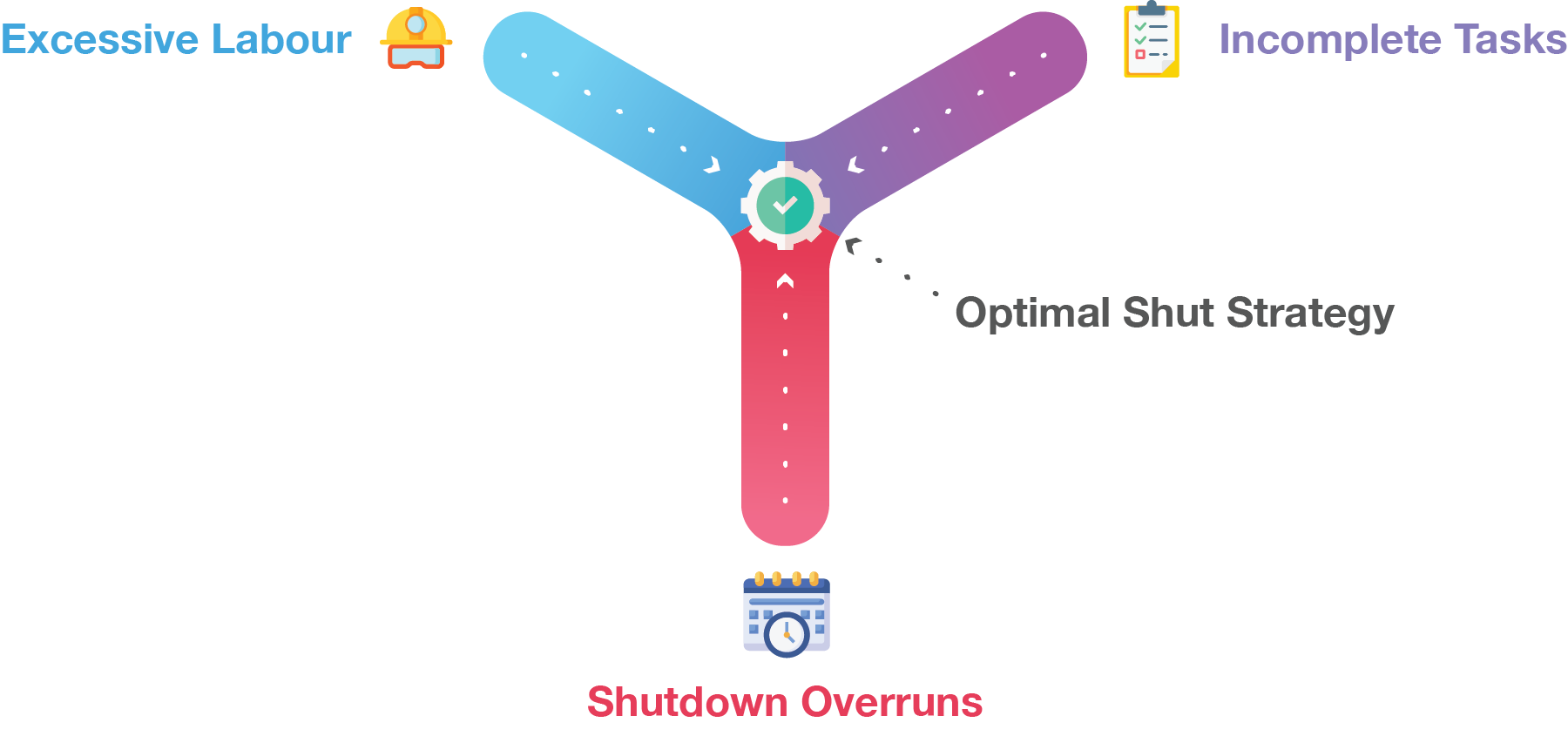Maximising the maintenance paradigm
Shutdowns may only last for a short period, but the initial planning and scheduling process can take months. Due to their scale and dynamic nature, shutdowns require significant amounts of time, labour and budget, which places a heavy burden on planning teams. In some industries, just one day of a shutdown overrun can result in millions of dollars of lost productivity, which is why shutdown planning teams are critical aspects of fixed plant management.
This article discusses the challenges and trade-offs that often exist when planning shutdowns. We'll reveal how using modern industrial mathematics can help alleviate the burden and allow planners to achieve their goals by staying on budget, minimising equipment downtime and improving plan compliance without compromising safety and quality.
The high-level problem
Fixed plant assets are at the centre of industrial productivity, which means asset availability and revenue are closely linked. However, they are complex machines that degrade over time and are costly to maintain. A trade-off therefore exists; under-maintenance compromises asset health (breakdowns and outages become unpredictable), whereas over-maintenance results in lost productivity. So how do planning teams determine the optimum amount of maintenance to perform?
Shutdown strategies
When approaching the complexities of shutdown planning, teams typically employ an overarching strategy dictated by the supply chain's complexity (interactions between different assets), broader system objectives, or historical experience. The strategy then influences decision-making during shutdown execution. Common shutdown strategies are:
Fixed shutdown durations
- This strategy prioritises shutdown duration over task completion.
Fixed shutdown tasks
- This strategy prioritises task completion over shutdown duration.

Each shutdown strategy has its own set of trade-offs which come with varying consequences, such as:
Incomplete tasks
- Regardless of task completion, the shutdown ends (fixed shutdown durations), and unfinished work is pushed to the next shutdown. This causes a 'bow wave' of tasks being continuously kicked to the next shutdown, which increases the risk of unplanned maintenance activities.
Excessive labour
- Throwing too many people at the shutdown to ensure plan compliance can create an unsafe work environment: too many workers and equipment in small spaces introduce safety risks. Teams may also obstruct other workgroups, reducing productivity and increasing labour costs unnecessarily.
Shutdown overruns
- Task over-scheduling or unplanned events can lead to shutdowns that take longer than planned. Extending the shutdown to complete all the scheduled tasks (fixed shutdown tasks) results in productivity loss and can have a trickle-down effect throughout the supply chain.
What is your company's shutdown strategy? Every planning team sits within this triangle by choosing which trade-offs best suit their overarching business goals and planning methodologies. But what if making trade-offs wasn't necessary?
Using industrial mathematics to optimise shutdown planning
The highly complex nature of planning and scheduling the thousands of interrelated maintenance tasks restricts how far into the future shutdowns can be planned. Mathematical optimisation can solve this planning problem by using a technique known as linear programming to build a mathematical model of the shutdowns. The model can then be solved to yield provably optimal solutions to the problem, in this case, tasking and scheduling shutdowns.
Polymathian's models approach shutdown planning on two levels:
Task Level
- The list of required tasks for each asset is input
- The optimal task list for each shutdown is output
Calendar Level
- The work inside each shutdown is an input
- The optimal shutdown calendar is an output
Task level
Task level optimisation models which tasks will be completed during a shutdown. To help visualise how complicated this problem is, imagine planning a large dinner party where you have 1000 tables with 10,000 guests, and every guest has a list of people they must and must not sit with (constraints). It's an impossible problem to solve at such a large scale, like planning shutdown tasks that number into the thousands and come with their own sets of constraints.
The scale of the problem is why planning teams often only plan 1-2 shuts into the future. Planning such a complicated and dynamic set of tasks requires weeks of effort, which could be wasted considering how frequently inputs change. As planning teams know, the inability to plan further into the future leads to short-sightedness and missed opportunities.
Here is where mathematical optimisation can help. Depending on the scale of the operation, optimisation can support 1-2 years of shutdown task planning across multiple assets in a single model. By simplifying and extending the planning horizon from months to years, planning teams can put their strategic thinking to use by exploring various scenarios:
- Can we confidently push tasks further into the future?
- Can more inter-task relationships be respected during planning?
- Can critical paths be minimised and calculated more accurately?
- Can the availability of labour and accommodations be respected?
Another benefit of using an optimisation model is its ability to produce optimal plans at the push of a button. In such a dynamic planning environment, it is incalculable how much time and effort can be saved from producing shutdown plans in minutes instead of weeks.
Case in point
When a major storm hit port facilities during maintenance activities, planners had to scramble to rearrange schedules and tasking using their current spreadsheet-based system. However, when that information was imported into GEAR, Polymathian's asset maintenance optimisation software (still in the client's testing phase), the planning team delivered a clear path forward and had their plan approved with minimal effort. The plan also included an additional benefit of coordinating with planning teams upstream at the production site. Without mathematical optimisation, these rapid planning changes would not have been possible, and the productivity losses would have continued for days into the future.
Calendar level
Calendar level optimisation prescribes when shutdowns should occur and for what duration. Shutdown scope is represented by scenarios with different shutdown types (full, partial, modular) in the calendar.
At this level of detail, an estimate of labour effort required for each shutdown is an input, rather than the tasks themselves. By avoiding planning at too granular of a level, planners can consider shutdowns much further into the future.
Let's go back to the dinner party we're planning. If our dinner party is scheduled eight years in the future, we know we need to 1) make dinner for our guests and 2) generally how much effort will be required, but it isn't necessary to know what exactly will be on the menu. The same concept applies to calendar level optimisation.
Optimisation at the calendar level supports more strategic planning to allow teams to align shutdowns over multiple years, which will result in:
- improved throughput (e.g., changes to drumbeats)
- minimised accommodation and labour constraints
Planning teams can then identify specific shutdowns where durations can be extended to allow for more maintenance tasks to be completed, thus improving equipment reliability. Or conversely, determine shutdowns where they can extend the time between shuts to improve productivity without compromise.
Case in point
A global commodities producer was looking to reduce safety risks related to the large workforce required to conduct shutdown maintenance without sacrificing maintenance efficiencies or plant throughput.
Using a decision support tool powered by industrial mathematics such as GEAR, the planning team looked more strategically at their long-term shutdown strategy and eliminated unnecessary shut windows. With support from GEAR, the planning team produced a strategy that reduced workers by 40% during peak maintenance periods. The reduction significantly improved site safety while improving overall plant throughput. Read the full case study.
Conclusion
Planning teams using software tools that leverage mathematical optimisation techniques are better prepared to address the unique challenges and opportunities associated with shutdown planning. Moving away from outdated spreadsheet-based planning and towards modern techniques such as optimisation, simulation, and machine learning models are empowering teams to:
- improve compliance to plan
- extend the period between shutdowns
- facilitate greater supply chain collaboration
- reduce shutdown costs
- improve productivity
Article contributor

Jackson Richards, Polymathian Product Leader
Jack has over 10 years experience developing complex optimisation tools. He has developed, deployed and maintained models in the mining, rail, shipping and energy industries. Jack has been involved in the mathematical development of many of Polymathian's products, and is currently product manager for GEAR and VOLT.
Interested in learning more about Jack? Check out his employee spotlight!





